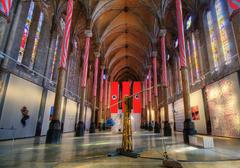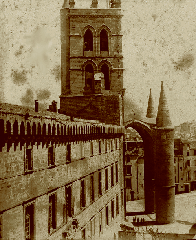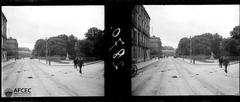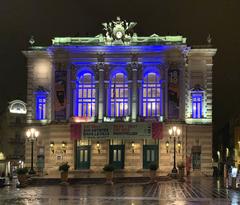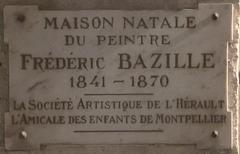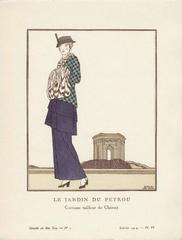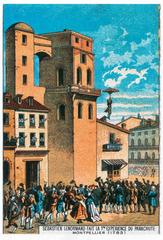
Prefecture Fountain Montpellier: Visiting Hours, Tickets, and Travel Guide
Date: 03/07/2025
Introduction
Nestled in the historic heart of Montpellier, France, the Prefecture Fountain (Fontaine de la Préfecture) has long stood as an emblem of the city’s rich cultural heritage and 19th-century urban elegance. Once located in the vibrant Écusson district, adjacent to the Prefecture of Hérault, this neoclassical fountain was more than a public ornament—it was a testament to Montpellier’s modernization, civic pride, and communal identity. This guide offers a comprehensive exploration of the fountain’s significance, practical visitor information, and recent transformations, ensuring travelers can appreciate Montpellier’s evolving urban landscape (Écusson Montpellier - Wikipedia).
Historical Context
The Prefecture Fountain originated during the 19th-century era of civic improvement, inspired by Haussmannian urban planning that reshaped many French cities. Its construction symbolized Montpellier’s ambition to blend public welfare with aesthetic enhancement, strategically placed near the administrative headquarters of Hérault. Officially designated as a Monument Historique in 1926, the fountain became a protected feature of France’s national heritage (Monument Historique Listing).
Architectural and Artistic Features
Design and Symbolism
Designed by sculptor Jean-Louis Journet, the fountain featured a central sculptural group within a circular basin, utilizing local stone and ornamental motifs. Its design reflected themes of abundance, renewal, and harmony between nature and urban life, while the flowing water symbolized vitality and prosperity (Fountain Symbolism).
Craftsmanship
Materials included durable local stone and fine bronze or ironwork, ensuring longevity and resilience. Decorative flourishes—floral patterns, classical figures, and allegorical elements—exemplified the craftsmanship of 19th-century public art (Commons Wikimedia - Fontaine de la Préfecture (Montpellier)).
Urban Integration
Location and Setting
The fountain was set within the Écusson district, Montpellier’s medieval core, surrounded by a mosaic of architectural styles. Its adjacency to the Prefecture and proximity to other civic monuments, such as the Arc de Triomphe and Place de la Comédie, reinforced its status as a civic and social anchor (Montpellier Historical Sites).
Civic Role
More than a decorative feature, the fountain served as a hub for gatherings, demonstrations, and community events, embodying French traditions of public space as centers of social life (Montpellier Tourism).
Visitor Information (Prior to 2024)
Visiting Hours: The Prefecture Fountain was accessible 24/7 as an outdoor monument, with no entrance fee or ticket required.
Accessibility: The surrounding area featured flat, paved walkways suitable for visitors with mobility challenges. Public transportation, including trams and buses, provided convenient access (Montpellier Tourist Office).
Travel Tips:
- Visit during early morning or late afternoon for optimal light.
- Explore nearby cafés and shops.
- Combine with a walking tour of the Écusson district.
Cultural and Social Significance
The Prefecture Fountain not only enhanced the city’s visual appeal but also symbolized Montpellier’s resilience, prosperity, and commitment to civic well-being. It was a favored meeting point and backdrop for ceremonies, photographs, and festivals, particularly in the lively Place du Marché aux Fleurs (France This Way; The Crazy Tourist).
Recent Developments: Removal and Urban Redevelopment (2024)
Fountain Removal
In 2024, Montpellier’s municipal authorities undertook a major urban redevelopment of the Esplanade Charles-de-Gaulle, leading to the careful dismantling and permanent removal of the Prefecture Fountain. This decision prioritized ecological sustainability, modern public use, and increased green space (AEF Montpellier; Monumentum).
Community Response
The removal sparked mixed reactions—some lamented the loss of a historical emblem, while others welcomed the city’s push toward greener, more inclusive public spaces. The transition prompted city-wide discussion about balancing heritage with innovation.
The New Fountains
Replacing the historic fountain, the Esplanade Charles-de-Gaulle now features a series of ecological fountains with:
- Closed-circuit water recycling systems
- Modern, interactive water jets
- Level, accessible designs for all users
- Enhanced landscaping and biodiversity
These changes reflect Montpellier’s vision of sustainable urban living (France Travel Blog; Participer Montpellier).
Visiting Montpellier Post-2024
Prefecture Fountain: As of late 2024, the original fountain no longer exists and cannot be visited.
New Fountain Installations: The Esplanade’s new fountains are open to the public, accessible at all hours, and free of charge.
Accessibility: The redeveloped area maintains high standards of accessibility, with level surfaces and adapted public transport (Montpellier Tourism and Disability).
Nearby Attractions:
- Place de la Comédie
- Promenade du Peyrou
- Musée Fabre
- Saint-Clément Aqueduct
- Jardin des Plantes
Travel Tips:
- Spring and autumn offer the most pleasant weather.
- Use the tram system for easy access.
- Combine your visit with guided walking tours for historical insight (Dreaming in French Blog).
Frequently Asked Questions (FAQ)
Q: Can I visit the Prefecture Fountain?
A: No, the original fountain was removed in 2024.
Q: Are there tickets or entry fees for the new fountains?
A: No, the new Esplanade fountains are open to all, free of charge.
Q: Are guided tours available?
A: Yes, many tours include Montpellier’s major historical sites and new urban features.
Q: What other sites should I visit?
A: Popular spots include Saint-Pierre Cathedral, Promenade du Peyrou, and Musée Fabre.
Summary & Recommendations
The Prefecture Fountain, once a beloved symbol of Montpellier’s civic history, now lives on in the city’s collective memory and cultural narrative. Its removal marks a turning point in the city’s ongoing evolution, emphasizing sustainability and inclusivity in urban design. Travelers are encouraged to discover the new fountains of Esplanade Charles-de-Gaulle and explore Montpellier’s wealth of historical and artistic attractions. For up-to-date guides, event schedules, and walking tours, download the Audiala app and connect with Montpellier’s vibrant community (Montpellier Events; Audiala App).
References
- Écusson Montpellier - Wikipedia
- Monument Historique Listing
- Fountain Symbolism
- Commons Wikimedia - Fontaine de la Préfecture (Montpellier)
- Montpellier Tourism
- France This Way
- The Crazy Tourist
- Facts.net
- Montpellier Events
- Lonely Planet
- Monumentum
- AEF Montpellier
- France Travel Blog
- Participer Montpellier
- Dreaming in French Blog
- France.fr
- Montpellier Tourist Office
- Montpellier Tourism and Disability
- Where and When
- OverYourPlace
- Audiala App


